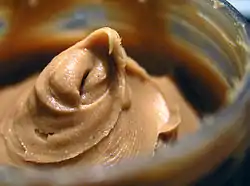Soft diet
A mechanical soft diet or edentulous diet or soft food(s) diet is a diet that involves only foods that are physically soft, with the goal of reducing or eliminating the need to chew the food. It is recommended for people who have difficulty chewing food, including people with some types of dysphagia (difficulty swallowing), the loss of many or all teeth, pain from recently adjusted dental braces, or surgery involving the jaw, mouth, or gastrointestinal tract.
A mechanical soft diet can include many or most foods if they are mashed, puréed, chopped very small, combined with sauce or gravy, or softened in liquid.
In some situations, there are additional restrictions. For example, patients who need to avoid acid reflux, such as those recovering from esophageal surgery for achalasia, are also instructed to stay away from foods that can aggravate reflux, which include alcohol, caffeine, chocolate, citrus fruits, ketchup and other tomato products, mint, and spicy foods. Foods such as blackberries and tomatoes may be restricted because they contain small seeds.[1]
Alternatives
A puréed diet is commonly used for people who have difficulty swallowing and provides a uniformly smooth consistency.[1]
Soft diets, particularly purée foods, can contribute to the high prevalence of malnutrition in those with dysphagia, especially in long-term care residents.[2] Such diets are often less palatable, and a reduction in food intake is common. Also, puréed diets are often poorer in calories, protein, and micronutrients than regular diets.[3]
Most of the foods on this diet can be both puréed and thinned with liquids to be incorporated into a full-liquid diet.
Examples
Desserts
.jpg.webp)
- Cake softened with milk or ice cream
- Cheesecake
- Cream pies
- Custard
- Fruit smoothies with crushed ice, milk, soy milk, or yogurt
- Gelatin desserts such as Jell-O
- Milkshakes and health shakes
- Mousse
- Soft pies, such as Key Lime pie, Pumpkin pie, and sweet potato pie
- Pudding
- Smooth frozen desserts such as frozen yogurt, ice cream, Italian ice, popsicles, and sherbet
- Whipped cream or whipped topping
Fruits and vegetables

- Applesauce
- Avocados
- Bananas, mashed if needed
- Creamed corn
- Creamed peas
- Creamed spinach
- Fruit juices
- Watermelon
- Peeled peaches or pears, very ripe or canned
- Soup with soft-cooked vegetables
- Vegetable juices such as carrot juice or tomato juice
- Vegetables cooked soft, mashed, or puréed
Grains/starches

- Baked potatoes, skinless, mashed with sour cream or cream cheese
- Breakfast cereal (Cheerios, Corn Chex, Corn Pops, Cornflakes, Rice Krispies), softened in milk
- Cooked hot cereals such as Cream of Rice, Cream of Wheat, Farina, grits, Maypo, oatmeal, porridge, Cream of Wheat, grits, Cream of Rice, Farina, Weetabix, or Wheatena
- Couscous
- Lasagne with extra sauce
- Macaroni & cheese, cooked soft
- Mashed potatoes and gravy
- Mashed sweet potatoes
- Muffins, pancakes, or waffles, softened with butter or syrup
- Pasta cooked soft
- Polenta
- Potato salad, mashed
- Quinoa
- Rice cooked soft, with sauce or gravy
- Rice gruel or congee
- Risotto
Protein

- Baked beans
- Canned chicken or canned tuna
- Chicken salad or tuna salad
- Chili
- Eggs, scrambled
- Eggs, beaten and steamed
- Cottage cheese
- Enchilada pie
- Fish cooked soft
- Meat in curries, soups, or stews
- Ground meat dishes, such as chili con carne, cottage pie ("Shepherd's pie"), hamburgers, meatballs, meatloaf
- Nut butter such as almond butter, cashew butter, Nutella, and peanut butter
- Refried beans with melted cheese, guacamole, salsa, or sour cream
- Ricotta
- Sloppy joe
- Tofu
- Yogurt
References
- White, Lois; Duncan, Gena; Baumle, Wendy (2010-01-27). Foundations of Basic Nursing. Cengage Learning. pp. 395–396. ISBN 978-1428317741.
- O'Keeffe ST (July 2018). "Use of modified diets to prevent aspiration in oropharyngeal dysphagia: is current practice justified?". BMC Geriatrics. 18 (1): 167. doi:10.1186/s12877-018-0839-7. PMC 6053717. PMID 30029632.
- Keller, H. & Chambers, L. & Niezgoda, H. & Duizer, L. (2012). "Issues associated with the use of modified texture foods". J Nutr Health Aging. 16: 195–200.CS1 maint: uses authors parameter (link)
